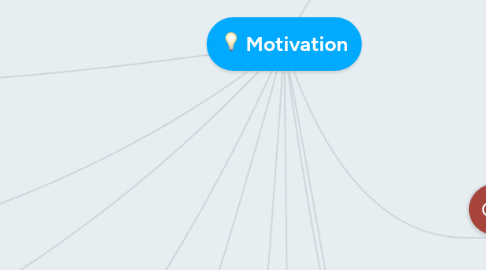
1. Forces
1.1. Direction
1.1.1. a particular goal
1.2. Intensity
1.2.1. level of effort
1.3. Persistence
1.3.1. amount of time
2. Goal Setting Theory
2.1. Effective goal
2.1.1. Specific
2.1.2. Relevant
2.1.3. Challenging
2.1.4. Commitment
2.1.5. Participation
2.1.6. Feedback
2.1.6.1. Specific
2.1.6.2. Relevant
2.1.6.3. Timely
2.1.6.4. Sufficiently
2.1.6.5. Credible
2.2. Limitations
2.2.1. if the goals are tied to monetary incentives
2.2.1.1. many employees tend to select easy goals
2.2.2. the incapability of applying goal setting to every performance dimension of every job
3. Needs Hierarchy Theory
3.1. Satisfaction-progression process / Needs
3.1.1. Self-actualization
3.1.1.1. self-fulfillment
3.1.1.2. realization of one’s potential
3.1.2. Esteem
3.1.2.1. self-esteem
3.1.2.2. social esteem
3.1.3. Belongingness
3.1.3.1. love, affection
3.1.4. Safety
3.1.4.1. a secure and stable environment
3.1.4.2. the absence of pain, threat or illness
3.1.5. Physiological
3.1.5.1. food
3.1.5.2. air
3.1.5.3. water
3.1.5.4. shelter
4. Theory of Learned Needs
4.1. Need for Achievement
4.1.1. High nAch
4.1.1.1. Prefer working alone
4.1.1.2. Desire unambiguous feedback
4.1.1.3. Money is a weak motivator
4.1.1.4. Successful entrepreneurs
4.1.2. Low nAch
4.1.2.1. Money is used as an incentive
4.1.2.2. Team leaders
4.2. Need for Affiliation
4.2.1. High nAff
4.2.1.1. Want to form positive relationships with others
4.2.1.2. Actively support others
4.2.1.3. More effective in coordinating roles
4.2.1.4. Prefer working with others
4.2.2. Low nAff
4.2.2.1. Better for making resource allocation decisions
4.3. Need for Power
4.3.1. High nPow
4.3.1.1. Want to exercise control over others
4.3.1.2. Rely on persuasive communication
4.3.1.3. personalized power
4.3.1.4. socialised power
5. ERG Theory
5.1. Growth
5.1.1. self-esteem
5.1.1.1. personal achievement
5.1.1.2. self-actualisation
5.2. Relatedness
5.2.1. interact with other people
5.2.2. receive public recognition
5.2.3. feel secure around other people
5.3. Existence
5.3.1. Physiologically related safety needs
5.3.2. & physically related safety needs
6. Two-factors Theory
6.1. Motivators
6.1.1. Outcomes
6.1.1.1. Satisfaction
6.1.1.2. No Satisfaction
6.1.2. Factors
6.1.2.1. achievement
6.1.2.2. recognition
6.1.2.3. responsibility
6.1.2.4. advancement
6.2. Hygiene Factors
6.2.1. Outcomes
6.2.1.1. Dissatisfaction
6.2.1.2. No Dissatisfaction
6.2.2. Factors
6.2.2.1. salary
6.2.2.2. working conditions
6.2.2.3. company policy
7. Innate Human Drives
7.1. Drive to Acquire
7.1.1. Need to take/keep objects and experiences
7.1.2. Basis of hierarchy and status
7.2. Drive to Bond
7.2.1. Need to form relationships and social commitments
7.2.2. Basis of social identity
7.3. Drive to Learn
7.3.1. Need to satisfy curiosity and resolve conflicting information
7.3.2. Basis of self-actualization
7.4. Drive to Defend
7.4.1. Need to protect ourselves
7.4.2. Reactive (not proactive) drive
7.4.3. Basis of fight or flight
8. Process
8.1. Unsatisfied Need
8.2. Tension
8.3. Drives
8.4. Search Behavior
8.5. Successful Effort
8.6. Satisfied Need
8.7. Tension Reduction
8.8. Environmental Change
9. Equity Theory
9.1. Elements
9.1.1. What employees receive
9.1.1.1. pay
9.1.1.2. promotion
9.1.1.3. recognition
9.1.2. Investment
9.1.2.1. skills
9.1.2.2. effort
9.1.2.3. experience,
9.1.2.4. amount of time worked
9.1.2.5. performance results
9.1.3. Outcomes
9.1.3.1. Underreward Inequity
9.1.3.1.1. Correcting methods
9.1.3.2. Overreward Inequity
9.1.3.2.1. Correcting methods
9.1.3.3. Equity
9.2. Organizational Justice
9.2.1. Distributive Justice
9.2.2. Procedural Justice
9.2.3. Equity Principle
9.2.4. Rules
9.2.4.1. Structural Rules
9.2.4.2. Social Rules
10. Expectancy Theory
10.1. Effort
10.1.1. Self-efficacy
10.1.1.1. Training
10.1.1.2. Abilities
10.1.2. Increasing methods
10.1.2.1. Train employees
10.1.2.2. Select people with required competencies
10.1.2.3. Provide role clarification
10.1.2.4. Provide sufficient resources
10.1.2.5. Provide coaching & feedback
10.2. Performance
10.2.1. Perceptions
10.2.2. Learning
10.2.3. Increasing methods
10.2.3.1. Measure performance accurately
10.2.3.2. Describe outcomes of good & poor performance
10.2.3.3. Explain how rewards are linked to past performance
10.3. Outcomes Valences
10.3.1. Increasing methods
10.3.1.1. Ensure that rewards are valued
10.3.1.2. Individualize rewards
10.3.1.3. Minimize countervalent outcomes
11. Challenges
11.1. Revised employment relationship
11.1.1. Potentially undermines trust and commitment
11.2. Flatter organizations
11.2.1. Fewer supervisors to monitor performance
11.3. Changing workforce
11.3.1. Younger staff have different needs
